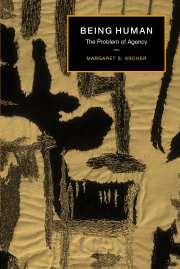Book contents
- Frontmatter
- Contents
- List of figures
- Acknowledgements
- Introduction
- Part I The impoverishment of humanity
- Part II The emergence of self-consciousness
- Part III The emergence of personal identity
- 6 Humanity and reality: emotions as commentaries on human concerns
- 7 Personal identity: the inner conversation and emotional elaboration
- Part IV The emergence of social identity
- Conclusion: the re-emergence of humanity
- Index
7 - Personal identity: the inner conversation and emotional elaboration
Published online by Cambridge University Press: 22 September 2009
- Frontmatter
- Contents
- List of figures
- Acknowledgements
- Introduction
- Part I The impoverishment of humanity
- Part II The emergence of self-consciousness
- Part III The emergence of personal identity
- 6 Humanity and reality: emotions as commentaries on human concerns
- 7 Personal identity: the inner conversation and emotional elaboration
- Part IV The emergence of social identity
- Conclusion: the re-emergence of humanity
- Index
Summary
So far, three clusters of emotions have been discussed as emergent commentaries, relating to our physical well-being, performative achievement and self-worth in the natural, practical and discursive orders respectively. Matters do not end there with a series of immutable first-order emotions, ranked as it were, simply by their relative intensity. They do not because of our human powers of reflexivity; our capacity to reflect upon our emotionality itself, to transform it and consequently to re-order priorities within our emotional sets. That there is some second-ordering process involved commands broad agreement. Thus Elster refers to it as ‘transmutation’, Greenwood as ‘transformation’ and Taylor as ‘transvaluation’, amongst those who have systematically dealt with second-order emotions. There the agreement ends, for two very different accounts are advanced about what the process of emotional revision entails. They turn out to have equal but opposite defects: one tends to rationalism (or rationalisation), whilst the other tends towards intuitivism.
On the one hand, there are (a) those who present this as a matter of cognitive reflection in which reason is brought to bear upon the beliefs underpinning first-order emotions, whose revision then leads to emotional re-direction (second-order). A typical illustration would be a person who goes into therapy to combat their agoraphobia, with the aim of strengthening their (partial) belief that open spaces are not really physically threatening and thus modifying their emotional response to their environment.
- Type
- Chapter
- Information
- Being HumanThe Problem of Agency, pp. 222 - 250Publisher: Cambridge University PressPrint publication year: 2000
- 1
- Cited by



